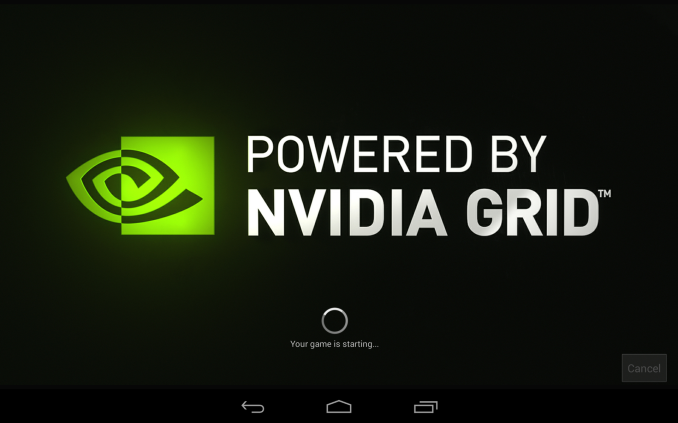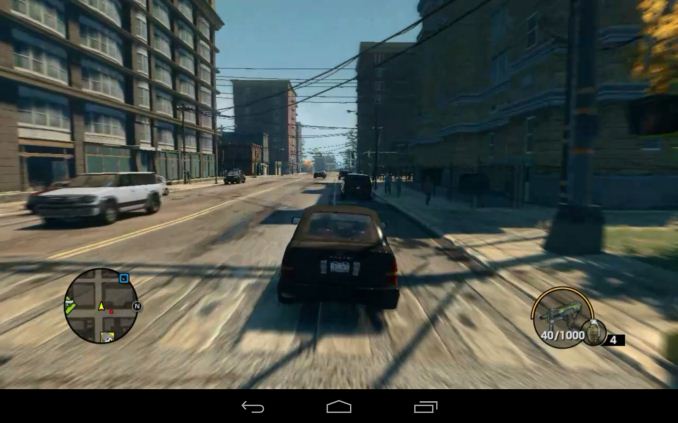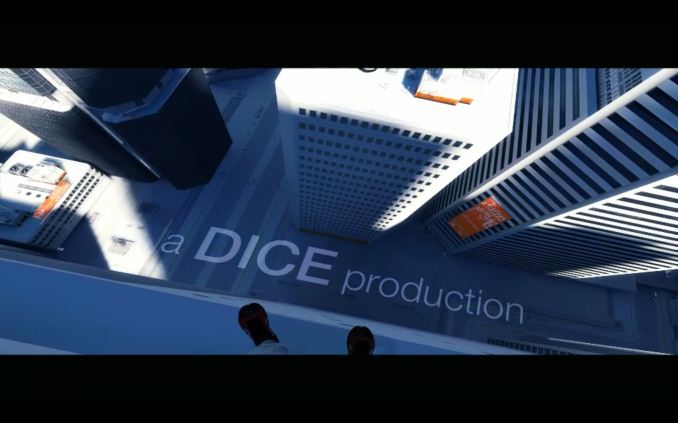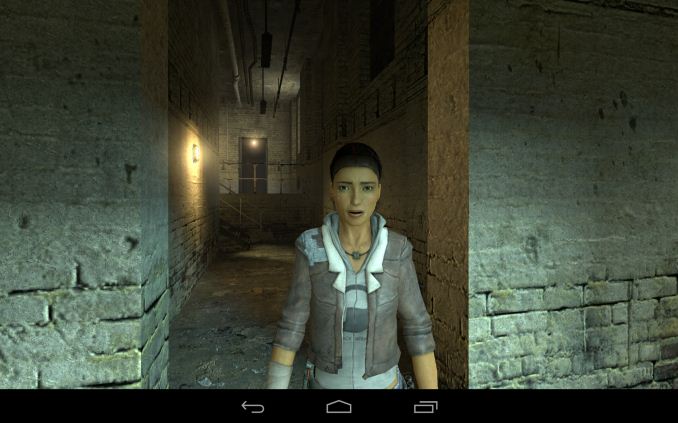The NVIDIA SHIELD Tablet Review
by Joshua Ho on July 29, 2014 9:00 AM ESTGameStream and GRID
The final software features that Shield Tablet brings to the table are GameStream and GRID. These are effectively methods of turning the tablet into a thin client, as all of the rendering/computation is done on a computer either in the LAN or on a server in San Jose. From a technical perspective, both work great as long as the connection has high bandwidth and low latency. For GRID, I managed to get a great user experience on a symmetrical 10 Mbps connection and around 10ms latency to the server. Games like Saints Row 3 played as if running on a console when the device is actually streaming from NVIDIA servers. From the user’s perspective, it’s a matter of going into the app drawer, opening GRID, and selecting a game. It’s simple and given sufficient server coverage I could easily see a Netflix-style usage model taking off quite successfully.
Although I didn’t spend as much time with GameStream, I didn’t detect any input lag and for the most part it’s just as simple. As long as a GameStream-enabled PC is on the same network, accessing GameStream compatible games is just a matter of going to the Shield Hub application, entering a four digit code on the PC to pair it with the tablet, and selecting a game. GameStream also works remotely, but the same caveats that come with GRID apply to GameStream on both the server and client end. Of course, the games that will run on GameStream have to be carefully selected. While it’s fully possible to play a twitch shooter like Call of Duty through GameStream, trying to use a controller in multiplayer is simply a massive disadvantage against people that are competent with a mouse and keyboard. I've included a screenshot of Mirror's Edge that I took while testing GameStream.
Gaming Ecosystem
Ultimately, I’m a bit conflicted on whether GameStream and GRID are really designed to stand on their own though. GameStream only works while you’re at home, and GRID is highly dependent upon low latency and also needs around 10 Mbps download and 5 Mbps upload for an ideal experience. Due to the latency requirement and the fact that the only GRID server bank is in San Jose, the very low latencies that GRID is best suited for are generally only achievable in California and parts of other nearby states. They’re definitely great in the situations that they work, but ultimately the native game library has to stand alone. To this end, the tablet is in a far better situation than the original Shield. The number of games that provide a quality gaming experience is now leaps and bounds better than what we saw with the launch of the Shield Portable. Trine 2 is included out of the box, and while I didn’t get a chance to try co-op mode it’s a compelling experience that once needed GameStream or GRID to be played on Shield. Along the same lines, the Grand Theft Auto series, Half Life 2, and Portal all play surprisingly well.
Fundamentally though, I don’t think single player games alone will sell Shield as a gaming platform. A single player game can only have a certain amount of replay value. Something like Half Life 2 might have 12 hours of gameplay at best. In comparison, multiplayer has massive amounts of replay value because even the same map can play out differently depending upon the people that play in the round. It’s that factor that makes it possible for people to spend 1200 hours playing a game like Battlefield 2. Unfortunately, for the most part the Shield tablet has a game library that seems to be skewed towards single player games. Fortunately, NVIDIA seems to understand this. While I haven’t been able to play War Thunder on Shield tablet, the promise of compelling multiplayer games on this device would be a strong enough reason to excuse potential shortcomings in other areas. Although it's good that an immersive multiplayer title is coming to Shield tablet, the key point of emphasis is that people playing a Shield device can play with those on console or PC as well. Until NVIDIA hits critical mass for Shield device adoption, multiplayer titles that only allow people on Shield to play with others on Shield will struggle because people won't play multiplayer unless there are other people to play with.















174 Comments
View All Comments
SpartyOn - Tuesday, July 29, 2014 - link
I guess it depends on your setup or what steps you're willing to take. I have an Asus Z77 wifi mobo so I use the Asus Wifi Go app a lot, which allows me remote desktop access and mirroring in an easy package. Haven't invested in a Bluetooth mouse or keyboard, but using USB OTG has worked out just fine for times I've hooked the Shield up to a monitor with M&K.I've done some video editing in Adobe Premiere remotely this way, along with working with Excel files, so I'd say it can actually do work just fine. Does it require some additional cables/accessories to maximize that professional potential? Sure, but then again, I'm not going to be doing any serious work on an 8" Shield tablet without hooking it up to a monitor as well.
fivefeet8 - Tuesday, July 29, 2014 - link
Much of the activities I do require me to be away from the home so a shield with a gamepad attached to the screen would be a bit awkward. The tablet fits more with my requirements.SpartyOn - Tuesday, July 29, 2014 - link
I think there's room for both devices for those that buy into the Nvidia brand and who understand/utilize the gaming features; however, the tablet space is a very competitive market for Nvidia to try and enter, with numerous players, especially for work and professional devices.An additional thought on the gaming side, since this really is the target audience: Does it pass the eye test? If I'm a gamer, and I see someone with a 1st gen Shield, I immediately know that it's a gaming device and might inquire what it is. I also can look at pics when shopping and know that it's a gaming device. If I see someone using the 2nd gen Shield, I just see another tablet out in the wild and when shopping online, it would have to come down to specs/features comparisons.
I guess the overall point I'm trying to make is this: the original Shield was so insanely different that over time it had a chance to succeed, especially with yearly refreshes. Now it's just another tablet that can't even stand up on its own (literally and figuratively) ... how do I balance a tablet in bed or on the couch (or in a plane, train, car?!) when I have to fiddle with a controller and the screen itself. Seems cumbersome for gaming to me and in my opinion actually makes you MORE tethered to a stationary external monitor/HDTV instead of the handheld.
fivefeet8 - Tuesday, July 29, 2014 - link
If there is enough demand for another Shield1 type device, then you may yet see it, but from what's been gathered, there wasn't. Although I do find it also an interesting device, the gamepad agnostic nature of the Tablet gives a better experience with 3rd party pads. Some of which are attachable albeit a bit weight slanted. And it gives console mode an advantage of not having to use another controller.aamir147 - Tuesday, July 29, 2014 - link
I believe the tablet is just another addition to the shield family, this is not to replace the shield portable. This is what the mod in the nvidia blog said.savagemike - Tuesday, July 29, 2014 - link
It would be trivial to make a frame to hold the tablet and controller together for use as you'd like. Meanwhile I was never attracted to the first Shield because gaming is not my number 1 interest - just something that would be a nice bonus.What I'm saying is this more modular approach could easily be made to work as the original Shield but the original Shield cannot be made to work as a stand-alone tablet. So for me this is a much better design.
Especially with the advent of 3d printing. It will only take one clever person to design something to hold the tablet and controller together to mimic the original. If you don't see it pop up soon for easy purchase then it isn't that wanted as it would be simple to do.
Knowname - Wednesday, July 30, 2014 - link
I think you should consider the directstylus modes. I'm sure the wife (if the tablet isn't too heavy) would love that. lus she could read and do other tablet stuffs... if she can get around the horribly dull screen ofc.schizoide - Tuesday, July 29, 2014 - link
You can pick up a refurb Nexus 7 (2013) for $140 from an authorized seller on eBay, or $230 full price and new. The shield tablet costs $300. What do you get for twice the money?From a tablet perspective:
- Slightly larger, but lower quality screen
- Stylus
- Dramatically improved speakers
- 28% heavier
- Maybe slightly snappier? Much faster in benchmarks, but the Nexus 7 2013 is fine for browsing and tablet stuff. I haven't seen anyone compare them in interactive use.
From a gaming perspective:
- Shadowplay, if you have a nVidia GPU in your gaming box and want to plug a tablet into your TV. Better off getting a haswell chromebox and installing steam for linux on it.
- Grid streaming, if you're in northern california.
- A couple Tegrazone games, primarily 10 year old PC ports.
- All the android games built for the lowest common denominator that play on your Aunt's Galaxy S2 will play here too.
In my opinion, the Shield tablet doesn't make a lot of sense as a tablet or as a gaming device. If it was priced competitively with the new Nexus 7, then certainly it would be interesting. If you want to buy a small android tablet and don't care about the $70 (or $160 for the refurb!) I guess go crazy. But will they sell a lot of them? No way.
Now if nVidia could get something like their GTX 860M and crunch it down to fit in a tablet TDP, and slotted it in alongside an atom CPU for a tablet running real Windows, with its massive software library, that could be truly attractive.
ams23 - Tuesday, July 29, 2014 - link
Shield tablet is already #5 in the Amazon.com best sellers list for tablets: http://www.amazon.com/Best-Sellers-Electronics-Com...Nexus 7 is a great tablet too, but the difference in SoC performance is quite large. Shield tablet has 2x higher CPU performance and 3x higher GPU performance in comparison, with a much more modern GPU too.
Note that many of the people getting the Shield tablet are upgrading from the original Nexus 7 tablet, so the difference for these people will be like night and day.
schizoide - Tuesday, July 29, 2014 - link
Yeah, it's beating the ipad air and mini. It just came out. You think that'll hold up?